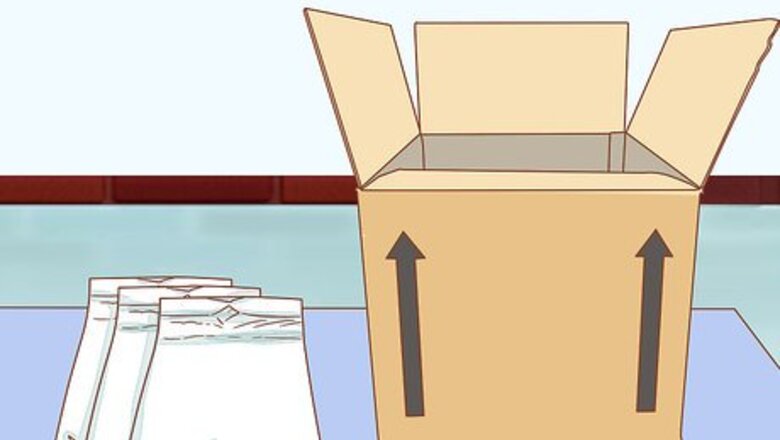
views
Gathering Supplies and Readying the Fish
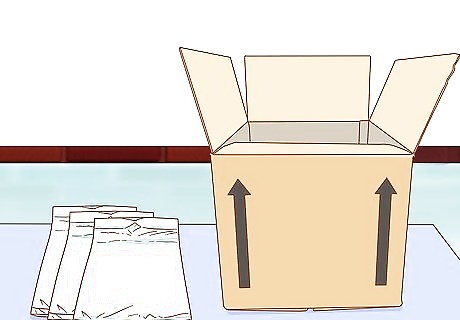
Buy shipping bags and boxes designed for fish transport. Choose plastic bags designed specifically for transporting fish—they should have flat bottoms when filled and be at least 3 mils thick (and ideally 4 or more mils). Likewise, use fish shipping containers that have sturdy cardboard outer boxes and inner Styrofoam boxes that fit inside perfectly. You can order these online from companies that deal in exotic fish supplies. You might also find them in fish supply or pet stores. The bags and boxes come in various sizes. If you’re putting a single fish in each bag—which is the safest method—choose bags that are about 3 times as wide as your fish breed’s average length. Choose the box size based on the number of bags you intend to ship at a time. Your chosen shipper might not absolutely require fish-specific bags and boxes, but they’re your best bet for getting your fish to their destination.
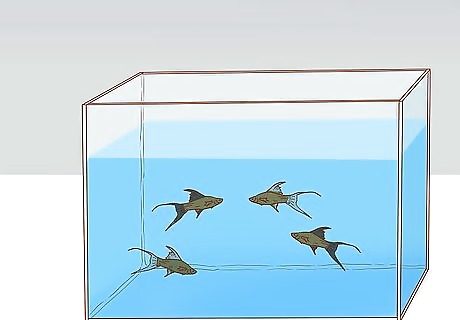
Place your fish in an isolation tank for 24-48 hours without feeding them. Move the fish you intend to ship to a separate tank that’s set at their ideal water temperature. Use an aerator and filter to keep the water clean, oxygen-rich, and conditioned properly based on the fish breed’s needs. Do not feed the fish while they’re in isolation. You want them to create as little waste as possible during their journey. Check for any signs of disease during this time, since you don't want to ship out diseased fish—especially to a paying customer.
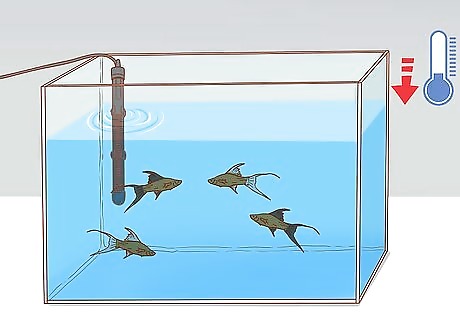
Decrease the water temperature gradually to your fish breed’s lower limit. During the 24-48 hour isolation period, incrementally reduce the water temperature from the ideal to the lower healthy limit for that fish breed. Turn down the tank’s heater a little more every few hours and check the progress with a tank thermometer. This process will slow their metabolism, which means they’ll consume less oxygen and produce less carbon dioxide and waste. You might think you should increase the temperature to make up for heat loss during shipping, but the box’s insulation—along with heating pads, if needed—will take care of that.
Bagging the Fish

Fill the bag less than half full of tank water, then add the fish. Basically, you want to fill the bag with just enough water to sustain the fish for their journey, and leave as much room for oxygenated air in the bag as possible. Once you’ve filled the bag one-third to one-half full of tank water, scoop up the fish in an aquarium fish net and add it to the bag. Get bigger bags if filling them halfway doesn’t provide enough water to cover the fish and allow them some amount of free movement. To scoop fish more easily, corral them into a corner of the tank with the scoop, then bring the scoop up from beneath them. Use steady movements instead of jerking motions that might frighten the fish. Experienced fish shippers know just how many fish they can fit into a single bag to maximize their efforts. Until you gain that amount of experience, however, it’s much wiser to place only one fish in a bag. You can, however, pack multiple bags into the box.

Add pure oxygen to the bag, if possible. If you have access to a canister of condensed oxygen, use it to inflate the bag after you’ve added the water and the fish. This will provide the water—and, in turn, the fish—with substantially more oxygen over the span of their journey. Otherwise, use a hand pump to fill the bag with room air. This should still be sufficient to sustain the fish for 2-3 days in most cases. Don’t inflate the bag by exhaling into it like it’s a balloon. You’ll fill it with carbon dioxide and the fish won’t survive the journey.
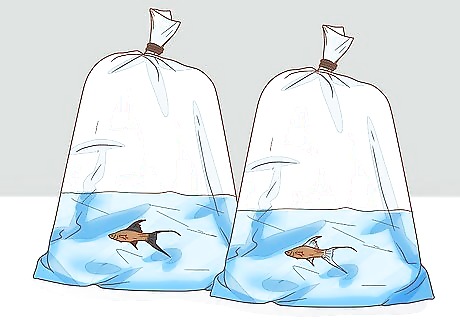
Secure the top of the bag tightly with rubber bands. Fold the flap over on the top of the bag, then keep wrapping and twisting a rubber band over the folded flap as many times as you can. Add a second or third rubber band for added security. While one high-quality bag should do the job, you can add some insurance by double, triple, or even quadruple-bagging the fish. Secure the tops of these extra bags after you’ve sealed the primary bag.
Boxing Fish for Shipping

Place insulating material and the bagged fish in the Styrofoam box. Line the bottom of the box with crumpled newspaper, bubble wrap, or Styrofoam packing peanuts. Then nestle the bag or bags into the Styrofoam box and fill the remaining open spaces with more crumpled newspaper (or other material). The packing material surrounding the bag, along with the Styrofoam box itself, provides protection during transport and helps insulate and maintain the temperature of the water inside the bag.
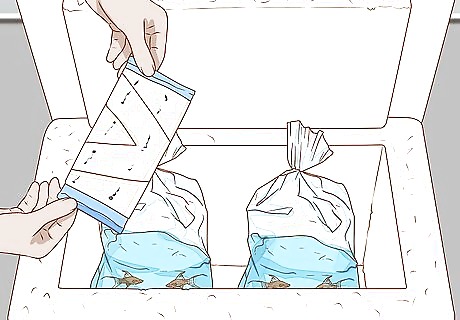
Add heat/cold packs wrapped in newspaper if necessary. Don’t freeze the cold packs or overheat the heat packs—instead, cool or heat them so they’re just slightly below or above the current water temperature. Then, wrap them in newspaper and nestle them in the insulating material surrounding the bag(s) of fish. The insulating material and Styrofoam should be sufficient to maintain the water temperature for at least 24 hours. However, if the box will be exposed to very high or low temperatures during shipping, if the shipping process will take more than 1 day, or if the fish are very sensitive to temperature fluctuations, add a few heat or cold packs. Don’t set a bag with fish directly on a heat/cold pack. Two heat/cold packs should be adequate for a small fish shipping box.

Seal the lid on the Styrofoam box, and place it into the cardboard box. Press the lid securely on the Styrofoam box—it should fit very snugly. For extra security, wrap some packing tape around the seam of the lid. Then, slide the Styrofoam inner box into the cardboard outer box—once again, it should be a very snug fit. Use a good-quality packing tape to seal up the cardboard box after you’ve placed the Styrofoam box inside it.
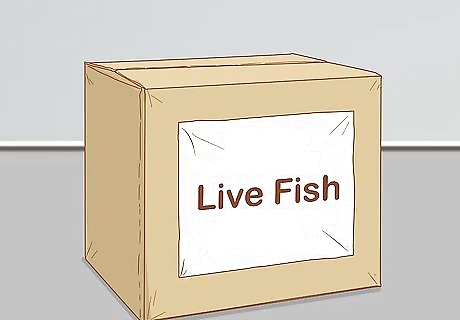
Add labels, like "fragile," "live fish," and "this side up" to the box. Most boxes designed for shipping fish will already be prominently labeled on the outside. However, it never hurts to grab a marker and add some additional labels. If your outer box isn’t pre-labeled, add a prominent “live fish,” “this side up,” and “fragile” notation to each side. Use large, block lettering that’s easy to read.
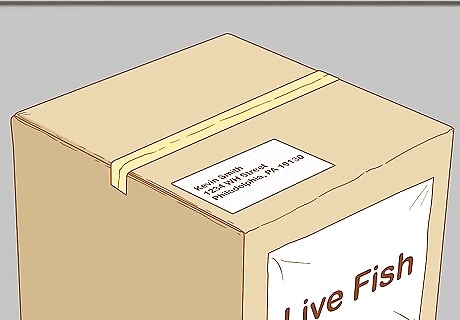
Address the box. Write the recipient’s address on the center of the box in large, clear lettering, then include the return address in the upper left corner. Affix any shipping labels as necessary.
Shipping Your Fish

Use a shipper that accepts live animal shipments. Don’t try to sneak an unlabeled box past a shipping company in order to save a bit of money. You’ll get much better results if you use a company that knows how to deal with live animal shipping. For example: The U.S. Postal Service accepts all live fish shipments, so long as you follow their packaging and labeling requirements. UPS will usually ship live fish if you give them proper notification beforehand and follow their packaging requirements. FedEx doesn’t ship live fish as part of their regular service—they may, however, provide business-to-business service through their Live Animal Desk.
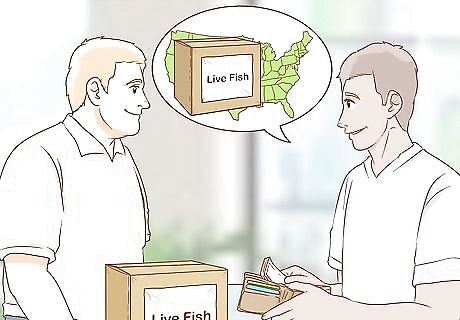
Pay for overnight/express shipping whenever possible. When it comes to shipping fish, the shorter the shipping time, the better. Overnight shipping is usually more expensive, but it gives the fish the best chance of arriving in good health. Work with your shipper to arrange for as few transfers and layovers as possible. If the fish will be shipped via air for at least part of the journey, try to arrange for climate-controlled storage during air travel. If you can get your fish to their recipient within 24 hours, the results will usually be good. 48 hours is more risky but often turns out okay. Longer shipping times become increasingly more dicey.
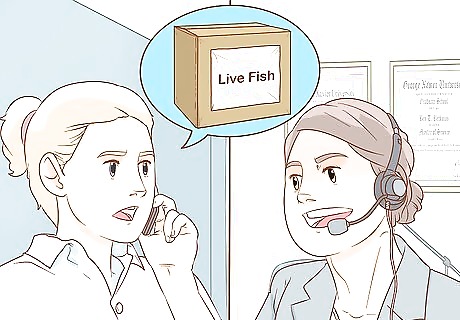
Coordinate with the shipping company and recipient for the box’s arrival. Contact the recipient and make sure that they will be ready to receive the fish when it gets there. Ideally, they should be able to accept the package directly from the delivery person. That way, they can open the box and start acclimating the fish to their new home right away.




















Comments
0 comment